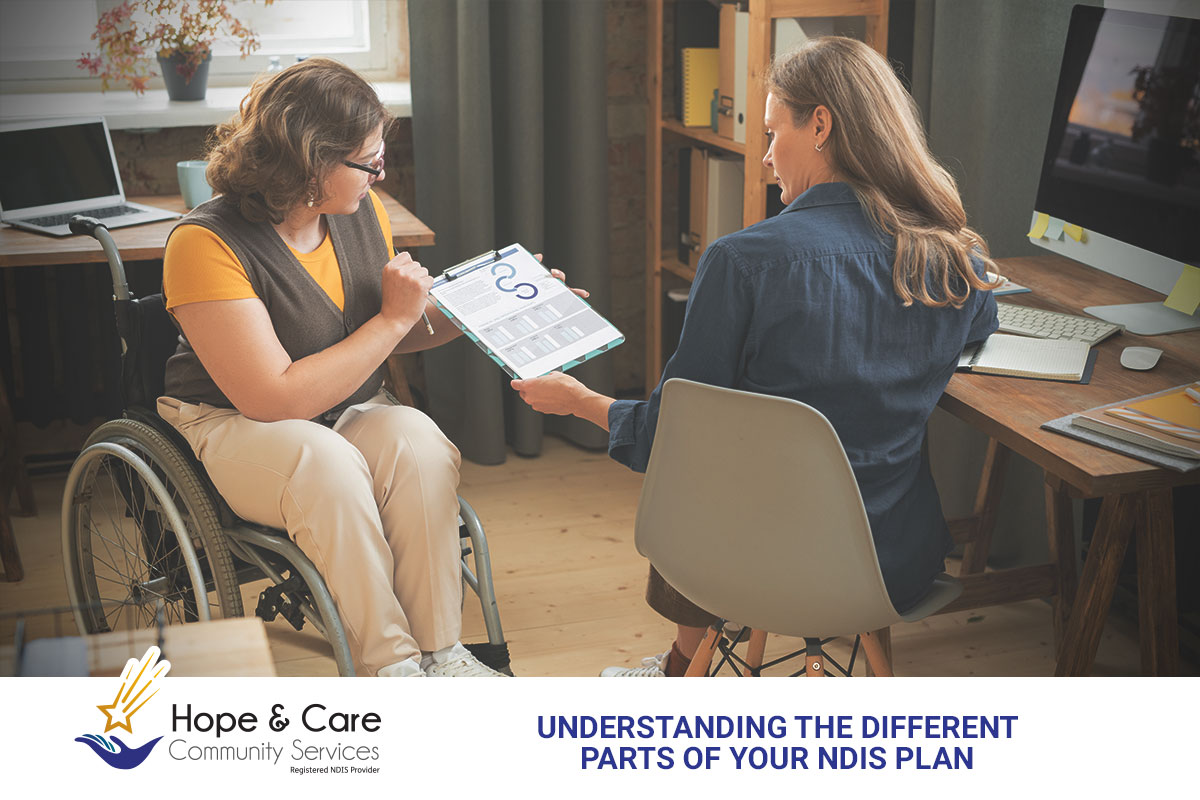
Your entire experience with the NDIS revolves around your NDIS plan. When you receive your plan, it’s exciting to start working toward your goals. However, it’s essential to review your NDIS plan first and ensure you understand each part. This guide from Hope & Care Community Services will help you make sense of your NDIS plan, so you can maximize its benefits and support.
What Will My NDIS Plan Look Like?
Most NDIS plans are straightforward and structured in a way that’s easy to follow. Here’s a breakdown of the different parts you’ll find in your plan:
Introduction
The plan begins with an introduction page. This page includes:
- Your name
- NDIS contact information
- Your plan start date
- The next review date
Profile
The profile page is your opportunity to introduce yourself to service providers. It contains:
- Basic information such as your date of birth and contact details
- A space to describe your future plans and aspirations
About Me
This open-ended section allows you to share more about your background, family, and goals. It includes:
- A personal narrative about your life and ambitions
- Information on your family, friends, and community involvement
Goals
Your goals section outlines both your short-term and long-term objectives. It includes:
- Detailed descriptions of your goals
- The supports you’ll need to achieve them
Types of Supports
This page describes the types of supports available to you, which we’ll explore in more detail later.
Funding, Plan Period, and Specifics
This part of your plan states your total funding amount and the duration of your plan. It also breaks down:
- Specific supports and their associated budgets
- Categories of support funding
Resources
The final page of your plan provides contact information and resources to help you understand your plan better.
Reviewing Your NDIS Plan: Common NDIS Vocabulary
When reviewing your NDIS plan, you might come across some unfamiliar terms. Here are a few common NDIS terms and their definitions:
Functional Impairment
This refers to the loss or damage of a physical, mental, or sensory function. For example, blindness or loss of sight is a functional impairment.
Functional Capacity
This is a person’s ability to communicate, interact, learn, or care for themselves. A reduced functional capacity means a person is less able to perform these activities.
Reasonable and Necessary
NDIS funding is provided for supports that are deemed reasonable and necessary. These supports must be directly related to your disability, and you’ll often need to provide evidence to justify their necessity.
Supports
Supports are anything that helps a person achieve daily living activities, participate in their community, and reach their goals.
Types of NDIS Supports
NDIS supports are categorized into three main types:
Capacity Building Supports
Capacity building supports help increase independence, skills, and abilities. For example, funding for physical therapy to improve mobility falls under this category.
Capital Supports
Capital supports include assistive technology, home or vehicle modifications, and other significant investments. An example is funding to install a wheelchair ramp in your home.
Core Supports
Core supports cover the essential services needed for daily living and achieving your goals. This category is flexible and can include things like daily assistance from a support worker.
NDIS Plan Management Options
There are three main ways to manage your NDIS plan: Self-managed, NDIA-managed, and plan-managed.
Self-Managed
If you choose to self-manage your plan, you’ll be responsible for:
- Setting up service agreements with providers
- Paying invoices and tracking finances
- Showing how funds were used during plan reviews
- Participating in payment audits
NDIA-Managed
With an NDIA-managed plan, the NDIA handles:
- Your funds
- Invoicing and payments
- Ensuring services are within price guide rates
- You can only use NDIS-registered providers
Plan-Managed
Plan managers are external agencies that assist with all aspects of your plan. They:
- Handle payments, service agreements, and financial reporting
- Provide flexibility to use both registered and non-registered providers
- Offer their services at no cost to you, as it’s included in your plan
Getting the Most Out of Your NDIS Plan with Plan Management Services
Plan management is crucial for achieving your NDIS goals. It simplifies the process by handling funding, ensuring providers are paid, maintaining financial order, and offering guidance on maximizing your funds.
Benefits of NDIS Plan Management Services
- Personalized Dashboard: Track your plan specifics easily.
- Dedicated Plan Manager: Get tailored support and assistance.
- Cost-Free Services: Included in your NDIS plan, ensuring no additional expense to you.
Conclusion
Reviewing your NDIS plan is essential to understanding and utilizing the supports available to you. By familiarizing yourself with each section and the common vocabulary, you can better navigate your plan and maximize its benefits. At Hope & Care Community Services, we are here to help you through this process, ensuring you have the support and resources needed to achieve your goals. Reach out to us for further assistance and guidance on your NDIS journey.
Finally, as Registered Provider, we understand the intricacies of the navigating services on your own. Unlock the full potential of your funding and provide the guidance you need to reach your goals. Feel free to Contact Us to explore how we can assist you on your journey. For instance, the NDIS is there to make a positive difference in your life, and we’re here to help!.
Want to learn more? Read other articles :
- Redefine Independence your own way – with HCCS
- Self-Managing vs NDIS Managed: Choosing the Best Path for Your NDIS Plan
- NDIS Guide : Navigating Step-by-Step
HCCS is a registered NDIS provider. Learn more about our services.
♥ We are available in Brisbane! – Our team is just a call away!
